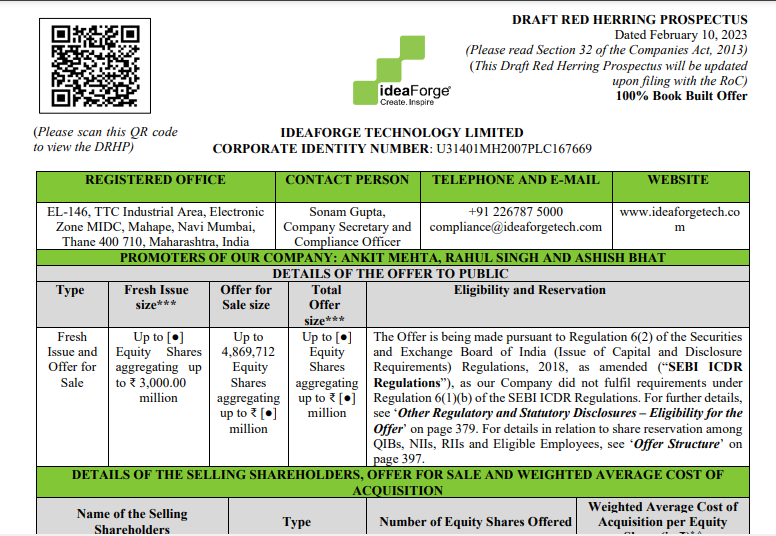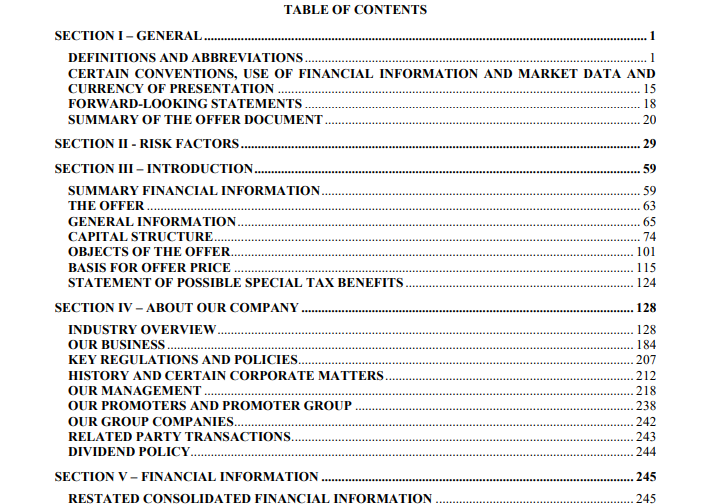DRHP: What is Draft Red Herring Prospectus?


00:00 / 00:00
Introduction
When a company decides to go public, it becomes accountable not just to its board and employees, but also to a new and diverse group of stakeholders — the public investors.
To aid this transition, a document is prepared that serves as a comprehensive guide to the company’s operations, its financial health, and future prospects. This document is the Draft Red Herring Prospectus (DRHP full form).
In amidst of noise in the market about new IPOs being announced every few days, how does a new investor decide which IPO to invest in?
While the company’s aim is to accumulate funds for growth, expansion, or debt repayment, the potential investors seek transparency, accuracy, and comprehensive information to make an informed decision. A DRHP is a crucial document to read before committing their money to any IPO.
What is Draft Red Herring Prospectus

The Draft Red Herring Prospectus meaning is that it’s a preliminary registration document filed by a company with the Securities and Exchange Board of India (SEBI) before it can issue an Initial Public Offering (IPO). A DRHP can run into several pages, the key content sections are:

Company Overview
This section provides a comprehensive summary of the company’s operations, including its business model, key products or services, organizational structure, and leadership team.
Industry Overview
DRHP contains vital information about various macro economic factors that impact economy in general and industry in particular.
For investors, a DRHP is a wealth of credible information for learning about a particular industry, players, growth prospects, size of the opportunity and potential.
Financial Statements
The DRHP provides detailed financial statements of the company, including balance sheets, income statements, and cash flow statements for the previous few years. It also includes auditor’s reports on these financial statements.
Risk Factors
Every business venture comes with its own set of risks. The DRHP lists potential risk factors associated with the company and its operations, providing investors with a realistic understanding of the potential challenges.
Legal and Other Information
The DRHP includes disclosures of any litigation involving the company, its directors, or its promoters. It also contains details of any regulatory or statutory violations.
Management
Management of a company, its promoters, directors and key employees play the most important role in leading a business in future.
DRHP contains details about key personnel their qualifications, experience and ability along with any red flags like legal cases, proceedings etc.
Details of the IPO
The DRHP outlines the specifics of the proposed IPO, such as the number of shares to be issued, the price band (if decided), the object of the issue and the proposed use of funds raised, terms and structure of the issue etc.
DRHP: A Crucial Tool for Investment Decision-making
Potential investors consider the DRHP as a vital tool for their investment decision-making. By evaluating the information provided in the DRHP, they can analyze the company’s profitability, growth potential, risk factors, and legality of operations, allowing them to make an informed decision.
Example: When Ola Electric recently announced its decision to raise funds via IPO, potential investors are eager to understand the company’s business model, financial health, and future prospects.
Markt awaits DRHP to be filed in next quarter, to assess Ola Electric’s revenue growth, its strategy to deal with competition, and plans for future expansion.
Key Statistics: In FY 2022-23, Indian companies raised Rs. 52,000 crores through IPOs, with the DRHP serving as a significant driver of these investments.
DRHP Meaning: Understanding the Fine Print
What is DRHP? While the DRHP meaning is packed with information, it’s essential to read the fine print and understand the terminology. F
or instance, the term ‘Red Herring’ signifies that the document does not have all the details of the public issue, specifically the price and the number of shares being offered. These details are usually finalized closer to the actual IPO date.
The ‘Draft’ indicates that the document is a preliminary version and subject to changes based on feedback from SEBI. The final prospectus, which includes all details of the IPO, is filed after receiving the approval from SEBI.
DRHP Benefits: Decoding Management Analysis and Corporate Governance
Beyond the financials and the risk factors, the DRHP also provides a peek into the management team and corporate governance practices, both of which are significant indicators of the company’s future performance.
- Management Analysis: This section typically includes the background of key management personnel, their qualifications, and their experience.
- Analyzing this can give investors a sense of the leadership driving the company and its strategic direction.
- Corporate Governance: The DRHP discloses the company’s corporate governance practices. Investors should look at the composition of the board of directors, their independence, and the functioning of various committees such as audit, remuneration, etc.
- Strong corporate governance practices often signal a well-managed company.
Deciphering the Purpose of the IPO
The DRHP reveals why the company is going public and how it intends to use the funds raised through the IPO.
- Fund Utilization: Companies can use IPO proceeds for various purposes like business expansion, debt repayment, acquisitions, or general corporate purposes. An investor should evaluate whether these objectives align with their own investment goals.
- Price Band and Dilution: The DRHP may indicate the expected price band for the IPO and the extent of equity dilution. A higher dilution could mean more shares being offered, potentially impacting future earnings per share.
A Look at the Promoters and their Holdings
The promoter’s stake in the company after the IPO is a critical piece of information contained in the DRHP.
A substantial promoter holding post-IPO typically suggests that the promoters have skin in the game, which is usually a positive sign for investors.
Example: In the case of the Zomato IPO, the DRHP indicated that post-IPO, the promoters’ stake would reduce to 84.6% from 86.2%.
This was viewed as a positive sign, indicating that the promoters had substantial skin in the game.
Where can you find the DRHP?
DRHP is available on SEBI’s website, stock exchange’s website, company and merchant banker’s website.
DRHP serves the role of a comprehensive marketing document, it is broadcasted by the company prior to IPO, you can find it in major newspapers, in different languages and on your broker’s website.
Open a free demat account with Rupeezy and enjoy free equity intraday trading, MTF at best interest rates and advance trading features.
Wrapping Up
In conclusion, the DRHP is an essential tool for prospective investors. It provides a comprehensive overview of a company’s business, financial performance, risk factors, and management.
An effective analysis of the DRHP can help investors make an informed decision about participating in an IPO. Invest in IPOs online with Rupeezy.
- The DRHP provides vital information, including the company’s business model, financial performance, risk factors, and details of the proposed IPO.
- The DRHP contains information about the management and corporate governance practices, offering insights into the company’s future performance.
- The document also reveals why the company is going public and how it intends to use the funds raised through the IPO.
- Understanding the promoter’s stake in the company post-IPO can indicate their confidence in the company’s future prospects.
FAQs
1. Why is it called Draft Red Herring Prospectus?
The document is referred to as a ‘Draft Red Herring Prospectus’ because it’s a preliminary version (draft) that doesn’t contain specific details about the issue size and the price band (red herring).
The term ‘red herring’ is derived from the legal phrase ‘red-herring prospectus,’ which is used because the document initially had a red border to signal that the information contained was incomplete or subject to change.
2. What is the difference between Draft and Red Herring Prospectus?
The main difference lies in their stage of preparation and level of detail. A Draft Red Herring Prospectus (DRHP) is the initial document submitted to SEBI, containing preliminary details about the company and the proposed IPO.
The Red Herring Prospectus (RHP) is the document issued post-SEBI’s observations, containing almost all the information except the issue price and the number of shares to be issued.
3. How do you read a Draft Red Herring Prospectus?
Reading a DRHP involves analyzing several key sections, including the company’s business model, financial statements, risk factors, management analysis, corporate governance, and details of the proposed IPO.
It also involves understanding the proposed utilization of the IPO’s proceeds and assessing the promoter’s stake post-IPO.
4. Why is it called DRHP?
DRHP stands for Draft Red Herring Prospectus. It’s called a ‘draft’ because it’s the preliminary version of the document that’s submitted to SEBI for review.
It’s called a ‘red herring’ because it does not have the specific details of the issue size and the price band, which are usually added after SEBI’s approval and closer to the actual IPO date.
The content on this blog is for educational purposes only and should not be considered investment advice. While we strive for accuracy, some information may contain errors or delays in updates.
Mentions of stocks or investment products are solely for informational purposes and do not constitute recommendations. Investors should conduct their own research before making any decisions.
Investing in financial markets are subject to market risks, and past performance does not guarantee future results. It is advisable to consult a qualified financial professional, review official documents, and verify information independently before making investment decisions.

All Category






